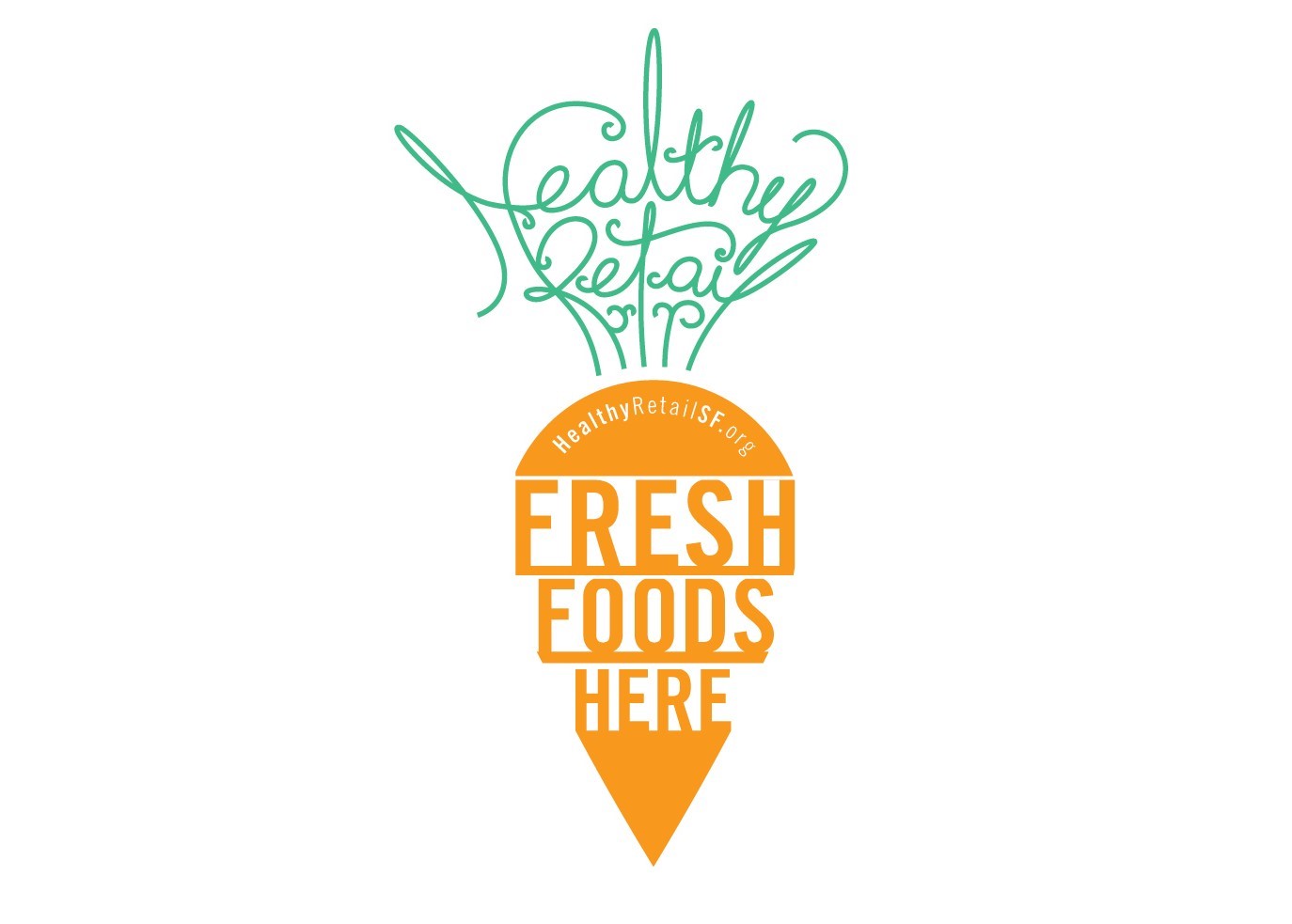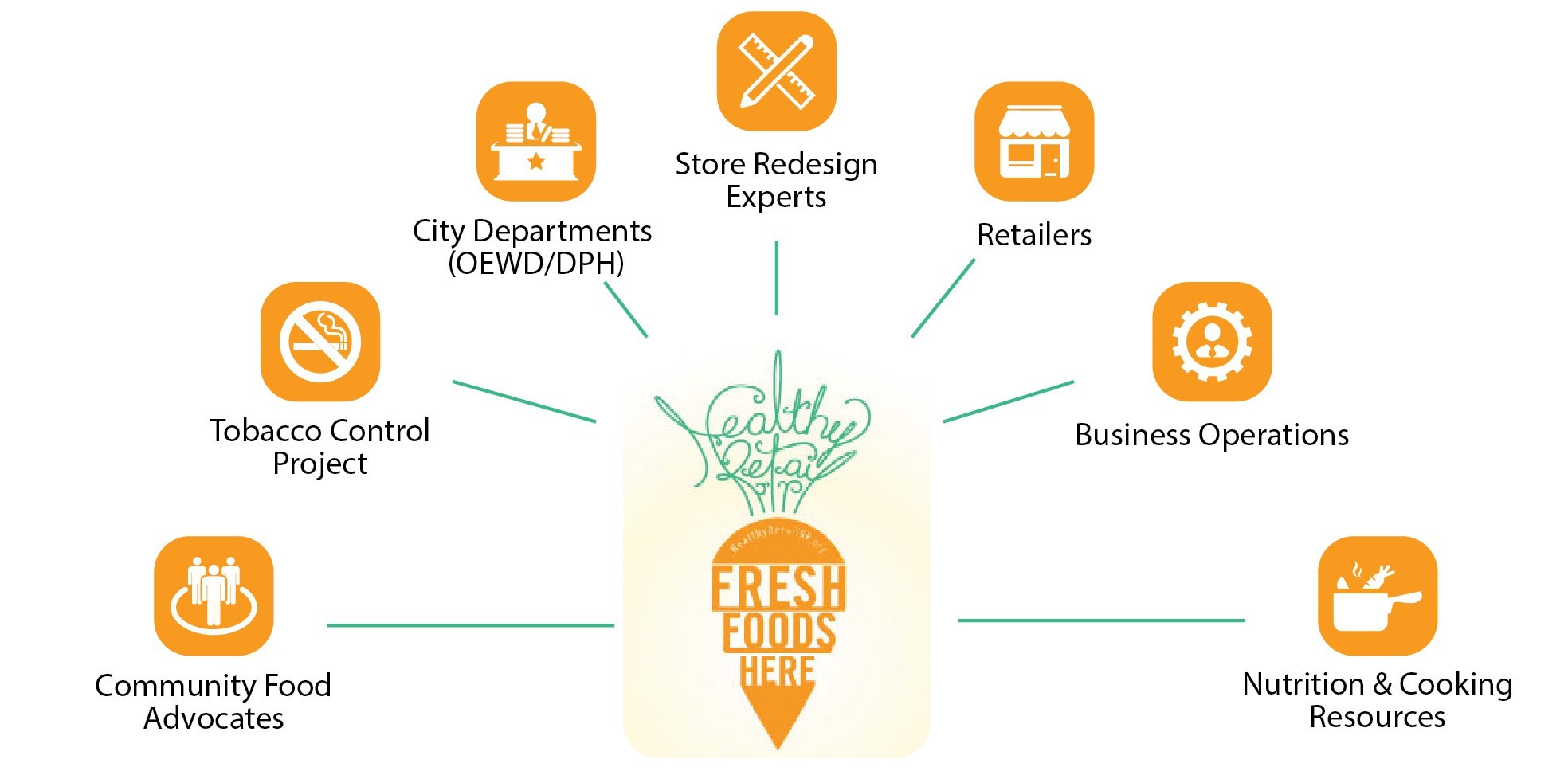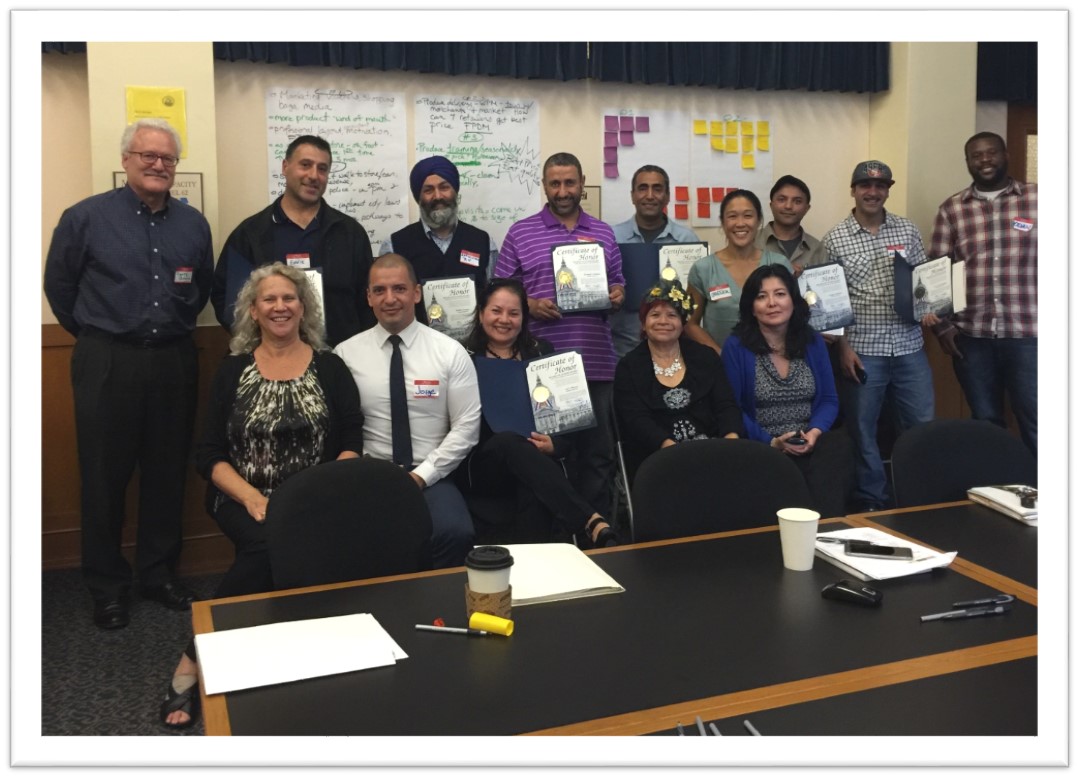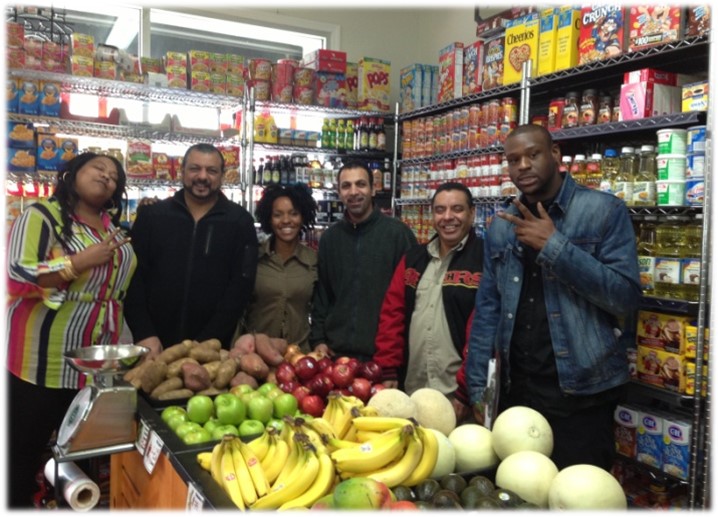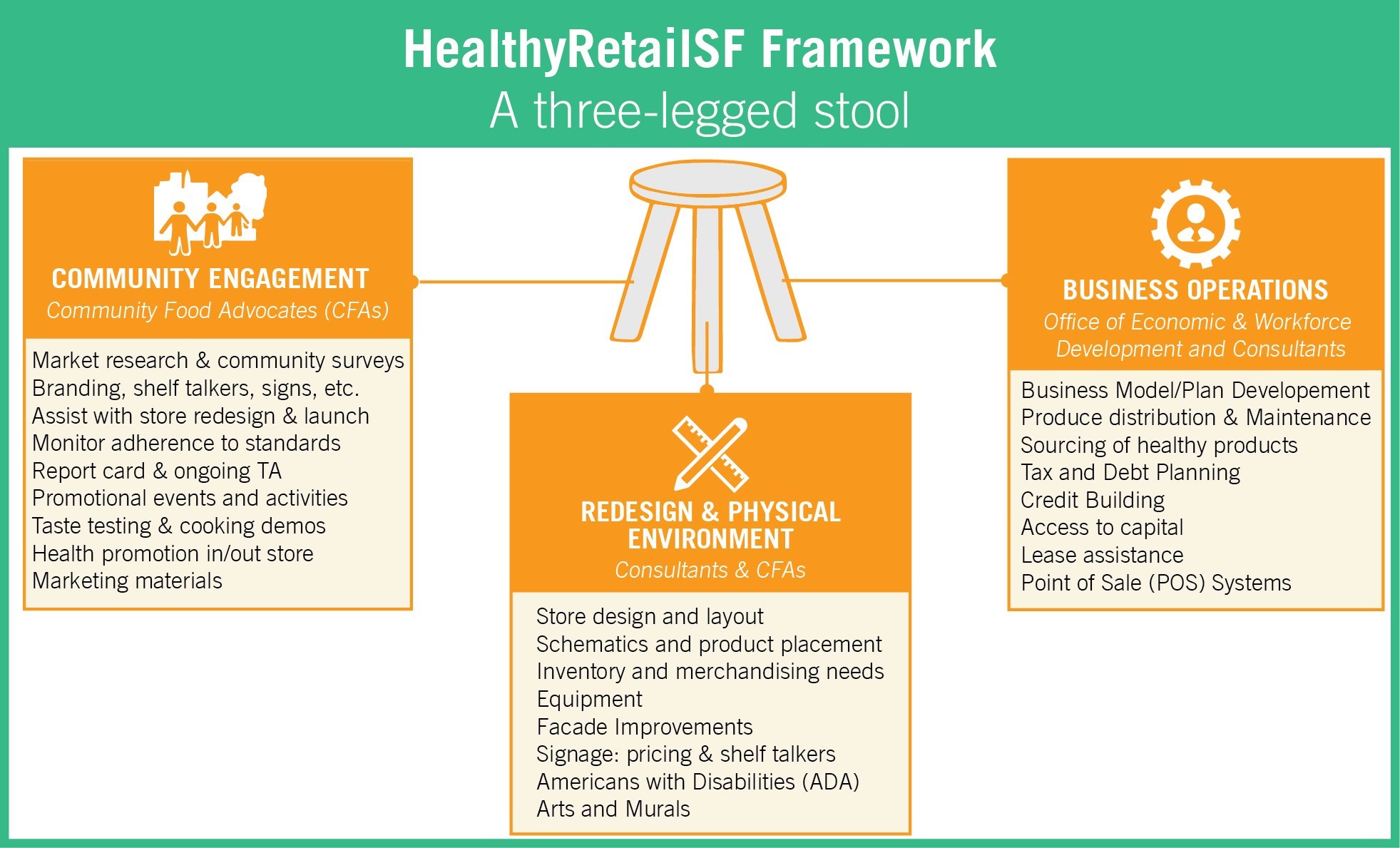- Introduction: History of Healthy Retail San Francisco
Healthy Retail San Francisco (www.HealthyRetailSF.org) is a unique public-private collaboration to transform neighborhood corner stores into healthy-food retailers in San Francisco’s “food swamp” communities. Housed in San Francisco’s Office of Economic and Workforce Development and staffed in partnership with the Department of Public Health, HealthyRetailSF redesigns corner stores to support the sale of fresh vegetables, fruits, whole grains, and other staple products. Store owners benefit from the store redesign, individualized consultation around business operations, and marketing. Residents benefit by being able to shop for healthy food in their neighborhoods.
Using a community empowerment approach, the mission of the program is to increase access to healthy food and decrease access and exposure to unhealthy products like junk food, sugary beverages, tobacco, and alcohol in San Francisco’s low-income communities.
HealthyRetailSF Objectives
- Redesign and transform corner stores as healthy-food retailers
- Improve the availability of healthy foods in corner stores
- Increase the amount of store revenue from healthy-product sales
- Reduce the amount of shelf space dedicated to selling tobacco and alcohol (<20%)
- Engage and empower communities in the transformation of retail environments
HealthyRetailSF provides a framework for city governments looking to eradicate food swamps and improve the environment and health of low-income communities. This case study provides an overview of the HealthyRetailSF program model and the key roles, strategies, and lessons learned that other jurisdictions should consider when starting a healthy-retail program. For a detailed history and timeline, please refer to the Appendix of this case study, called “Building a Movement: A Brief History of Healthy Retail San Francisco.”
Key Terminology
“Food security” is the concept that all communities should have healthy, easily accessible, affordable, and culturally appropriate foods.
“Food deserts” are neighborhoods without ready access to fresh, healthy, affordable food.
“Food swamps” are neighborhoods saturated with unhealthy food, beverages, tobacco, and alcohol. Advocates in San Francisco use this word to describe “food desert” communities.
“Corner stores” are nonchain neighborhood shops found in densely populated urban areas in which family owners typically work.
“Healthy-food retailers” are corner stores where the business model supports the sale of fresh produce, whole grains, lean proteins, and low-fat dairy products, and minimizes the store’ for tobacco and alcohol products (ideally, 20% or less of the space).
Why Healthy Retail?
Environmental and social factors contribute to health inequities in low-income neighborhoods, where residents face disproportionately high rates of preventable chronic disease, such as obesity, diabetes, heart disease, and hypertension. Healthy diets can prevent these diseases. However, many low-income residents cannot access affordable and nutritious food in their neighborhoods. A lack of full-service grocery stores and affordable healthy restaurants means that residents often have to choose between fast-food restaurants and corner stores that have limited healthy offerings. Healthy Retail aims to improve food security and support health in low-income neighborhoods by transforming corner stores.
Commonly owned and staffed by families, corner stores are very small businesses operating under considerable pressures to stay afloat. Many stores rely on free equipment, promotions, and advertising provided by major snack-food, sugary-beverage, tobacco, and alcohol companies to support their business models. As a result, people who shop at corner stores are subject to aggressive marketing, promotion, and messaging with respect to unhealthy products. HealthyRetailSF offers an answer to a key challenge in community health: how can a city and a local community support a corner-store business model that promotes health?
The History of HealthyRetailSF
As early as 2002, community leaders in the predominantly low- income and African American Bayview- Hunters Point neighborhood were organizing to transform corner stores into healthy retailers. Funded by the San
Francisco Department of Public Health’s (DPH) Tobacco-Free Project, community leaders launched the Good Neighbor Project, a pilot project to transform corner stores into healthy retailers in Bayview. The first store—Super Save— was transformed in 2004, followed by a few others. Additional stores were slated for remodel until the financial crisis stalled the program. At the same time, the Shape Up San Francisco coalition responded to a call from Bayview community members to create the Southeast Food Access Working Group (SEFA). With the partnership of DPH staff and Sutti Associates—a private firm specializing in grocery- and retail-store design— SEFA evolved the healthy-retail model to include store redesign and transformed three more Bayview corner stores between 2012 and 2013.
Organizations and community members in the low-income Tenderloin neighborhood took notice of the efforts in Bayview and came together to form the Tenderloin Healthy Corner Store Coalition (TLHCSC). Youth and community advocates surveyed community members, developed relationships with corner-store owners, and released annual shopping guides to rate neighborhood stores on health factors. In 2014, TLHCSC launched its own corner-store pilot conversion at Radman’s Produce Market. The Tobacco-Free Project served as the original project funder and as a liaison between efforts in Bayview and the Tenderloin, providing resources and technical assistance and aligning community strategies.
Recognizing an opportunity to share resources and scale the program, SEFA and TLHCSC leaders advocated for the City of San Francisco to fund and manage a citywide healthy-retail program. Championed by Supervisor Eric Mar, the San Francisco Board of Supervisors adopted legislation that created HealthyRetailSF in late 2013. Staffed by the Department of Public Health and the Office of Economic and Workforce Development (OEWD), where it’s housed, HealthyRetailSF and the community coalitions have transformed eight corner stores as of the end of 2015.

- What is the HealthyRetailSF Program:
HealthyRetailSF is a comprehensive five-step model for transforming corner stores into healthy food retailers. The HealthyRetailSF team conducts outreach to corner stores and assesses the physical, operations, and engagement level of stores using a criteria point system to select participating stores (steps 1 and 2). The team develops detailed Individualized Development Plans (IDPs) that outline a store’s redesign, such as removing signage and advertising for unhealthy products, accessing produce distributors, refrigerating and maintaining produce quality, and promoting healthy products though product-placement strategies (step 3). The plan is then implemented, whereby HealthyRetailSF provides individualized technical assistance to participating stores for three years to ensure the sustainability of the new business model (step 4). Finally, numerous evaluation metrics are applied to evaluate impact over time (step 5).
The HealthyRetailSF Model of Store Redesign
Business operations, physical changes to the store, and community engagement and marketing represent a “three-legged stool”—the foundational and interrelated elements of HealthyRetailSF’s approach to store redesign.
Business Operations
The business operations component focuses on removing business-related barriers for the merchant to be successful in their transition into becoming a healthy-food retailer. HealthyRetailSF leverages existing OEWD business programs and partnerships and its partnership with the San Francisco Small Business Development Center (SBDC) to provide tailored, direct one-on-one technical assistance to business owners. The assistance increases the business owner’s capacity to operate under their new business plan and provides them with the tools necessary to sustain and grow their business.
- Initial Business Evaluation: HealthyRetailSF reviews each store’s operations (i.e., lease, debt, and credit) to provide recommendations that will strengthen the store’s business.
- Store Selection: Program staff and partners play a role in the selection of stores.
- Business Support and Implementation: A customized suite of resources, programs, and incentives are developed to strengthen the business model and operations of each store.
Redesign and Physical Environment
The physical environment component focuses on redesigning the physical space and preparing the business for the introduction of produce and new healthy products. HealthyRetailSF benefits from a strong partnership with Sutti Associates, a local design and architecture firm with expertise in grocery-store design, merchandising, branding, and product placement. HealthyRetailSF helps stores promote and sell healthy products, decreasing owners’ reliance on the sale of tobacco, alcohol, and junk food.
- Design Evaluation: HealthyRetailSF evaluates the layout of the business, including the current equipment, shelves, merchandise, and safety concerns, and makes recommendations that accommodate the new business model.
- Business Support and Implementation: Individualized Development Plans (IDPs) outline the changes to the retail space and identify the resources, programs, and incentives that will address the needs of the small The retail-space redesign may include a new floor plan; improved shelving units, refrigerators, and watering systems that can support fresh foods; the removal of tobacco and alcohol advertising; the moving of unhealthy snacks to the back of the store; façade improvements; awnings; branded produce price signs and nutrition promotion; and the identification of product-placement alternatives for nonhealthy products.
Community Engagement
HealthyRetailSF recruits and trains a team of resident experts to serve as Community Food Advocates in their neighborhoods. This leg of the model supports community ownership of the effort and creates an opportunity for the community to inform change in their neighborhoods.
- Access Community Voice: Advocates survey, observe, and talk to community members to collect information about the community’s needs and preferences when it comes to accessing, eating, and cooking healthy foods. They share these priorities with store owners and project partners.
- Corner-Store Support: Advocates develop close relationships with store owners through monthly site visits. They provide store owners with support and technical assistance during and after the store remodel.
- Publicity and Promotion: Advocates conduct a store“launch” or grand reopening event for each redesigned store, which may include new promotions and banners, taste-tests of new healthy products, cultural events, a press conference and media advocacy with local policymakers or community leaders, store tours, and other activities and incentives that promote the stores to the neighborhood and beyond. The launch promotes the store’s conversion and creates community pride.
Criteria for HealthyRetailSF Store Selection
- Business Stability: Including years in business, lease status, licensing requirements, existing deb
- Store Motivation and Commitment: Merchant interest in the program, staff availability, and capacity to execute healthy retail tasks such as going to the produce market
- Location: Proximity to families in the community and ADA accessibility
- Community Engagement and Reputation: Ratings, relevance, and frequency of use by local community
- What is Unique about HealthyRetailSF:
HealthyRetailSF represents an upstream approach to the public-health problem of “food swamps.” Every community is unique; however, the San Francisco experience may provide lessons learned that could be applied to other communities.
Build a Strong Alliance with Retailers
Of the 1,150 corner stores in San Francisco, nearly 1,000 have less than four employees. Policymakers and community stakeholders want to support the city’s ability to retain and grow its small business sector; however, small business owners feel the pressure of increased regulation. In the same year that HealthyRetailSF began, small business owners were concerned about the sugar-sweetened-beverages tax, the growing number of big-box retail stores, and efforts to reduce the number of stores with tobacco-retail licenses. In an effort to protect the viability of their business, store owners may resist government-led efforts, including campaigns to transform the retail environment. While many support the goals of healthy retail, the retailer voice has often been absent. However, HealthyRetailSF represents a new paradigm for alliances between small businesses and community health coalitions.
Community coalitions partnered with the Arab American Grocers Association (AAGA)—one of the key corner-store organizers in San Francisco—to better understand the merchant perspective and identify resources, incentives, and assets that would benefit them and encourage store-owner participation. Understanding the needs, interests, and concerns of retailers helped HealthyRetailSF plan and promote a program that was a “win” for small businesses and a “win” for community health. This alliance also helped inform retailers that HealthyRetailSF is a free and voluntary program that provides access to bundled incentives that benefit their business goals while benefiting the overall well-being of the community.
For example, an important lesson learned in HealthyRetailSF store redesigns is the need to build the capacity of store owners to purchase, stock, and care for fresh produce in their stores. Most products in corner stores are nonperishable or do not require daily purchasing. HealthyRetailSF partners have provided hands-on technical assistance on how to pick fresh produce, remove spoiled produce, and use and adjust refrigeration systems. The alliance allowed small business owners to educate HealthyRetailSF about these needs, which the program was able to respond to and meet.
Access, Develop, and Prioritize Community Leadership
Before HealthyRetailSF was a city-supported program, community coalitions were surveying their neighbors, assessing their stores, raising funds for store conversions, and advocating for a program for healthy corner stores. Advocates, including Food Justice Leaders and Food Guardians, were instrumental in collecting and sharing data and consumer perspectives about the lack of healthy food and the high prevalence of tobacco and unhealthy products in these neighborhoods. Defining the problem and developing the message from a community perspective helped make the case for passing the HealthyRetailSF policy.
HealthyRetailSF continues to rely on the expertise of community members for program delivery. Community Food Advocates are experts in their neighborhoods. They understand the problems, develop solutions, and communicate and message the program to their neighbors and community leaders. Their presence allows them to build alliances with store owners and residents that public-health professionals would not be able to achieve on their own.
Sustain Community Solutions through Public-Private Partnership
With funding and support from the San Francisco Tobacco-Free Project (TFP) and other funders, community coalitions in the Bayview and Tenderloin neighborhoods were able to test the healthy-corner-store concept through pilot store conversions. These pilots taught the coalition about the need for all three legs of the HealthyRetailSF stool to ensure retailer participation and sustainability of the program. HealthyRetailSF used these early lessons to bring together the collaborative partnership between local public agencies, private companies, community members, and retailers. Each partner plays a unique but interconnected role in supporting small business transitions and community health.
Break Down Silos in Public Programming
Public-health funding streams often lead to siloed programming—for example, nutrition programs, tobacco-control programs, and substance-abuse programs operate independently of each other, despite the overlap in the public-health goals and intended outcomes of each. HealthyRetailSF addresses multiple public health goals by incorporating tobacco-control, alcohol-prevention, and nutrition objectives simultaneously.
TFP provided seed funding, data-collection support, strategic advice, and technical assistance to community coalitions working to transform the retail environment in Bayview and the Tenderloin. TFP leveraged relationships and resources to connect these coalitions to local city agencies and private partners to incorporate a tobacco-control and healthy-food and healthy-drinks agenda into their solution for food swamps.
TFP funds organizations through the Community Action Model (CAM) framework, which is rooted in community capacity building and popular education. The forefathers of HealthyRetailSF—the Good Neighbor Project, SEFA Food Justice Leaders and the Tenderloin Healthy Corner Store Coalition—were supported through CAM grants. Other jurisdictions can consider the CAM model as a framework for supporting community-driven public health solutions for multifaceted challenges.
- What Does It Take to Scale a Healthy Retail Program:
To date, HealthyRetailSF has converted eight corner stores into healthy-food retailers, and two more stores are slated for conversion in 2016. Store conversions cost approximately $20,000 each in physical upgrades and in-kind services. Healthy-retail programs like HealthyRetailSF are structured to support three outcomes: increase the portion of store revenues that comes from healthy-product sales; improve the overall retail environment; and increase access to and consumption of affordable healthy foods by community members living in food swamps. While measuring progress on these outcomes can be challenging, HealthyRetailSF has gathered preliminary data.
- Radman’s Produce (2014)
- Daldas Grocery (2015)
- Amigo’s Market (2015)
- Mid-City Market (2015)
- Lee’s Market (2013)
- Kennedy’s Market (2013)
- Friendly Market (2015)
- Ana’s Market (2014)
Healthy Product Sales
To track changes in retail sales and revenues with respect to healthy and unhealthy products after the store redesign, point-of- sale systems were placed in HealthyRetailSF stores. Early data reveals that healthy-food retailers have increased sales since the store conversion. The combined total sales of four stores increased by 25% in the first six months of participating in the program.
All the retailers are selling more produce. In the first six months, one store was selling, on average, more than three times as much produce, six times as much water, and 10 times as many healthy snacks. Initial data also shows that tobacco sales have decreased in two of the stores. Measuring sales data, however, does not answer the question of whether or not people in the neighborhood are eating healthier. The San Francisco Food Security Task Force piloted EatSF, a produce voucher program for community members with chronic diseases to increase their access to affordable healthy food in their own neighborhoods. These vouchers are accepted at HealthyRetailSF stores and other neighborhood stores that sell healthy foods. In its first year, 83% of EatSF vouchers were redeemed at these stores, representing a total of $28,000 in produce purchased by community members in their own communities.
Ripple Effect on Nonparticipating Stores
An initial program assumption was that the entire retail environment would benefit from HealthyRetailSF because neighborhood competitors might start selling healthy products after seeing improvements in sales at participating stores. Data from the healthy-food shopping guides may point to some improvements in the overall health of the retail environment. Between 2013 and 2014, the number of stores in the Tenderloin with a poor health rating (one or two stars) decreased, while the number of stores with a good health rating (three or four stars) increased.
The Future of HealthyRetailSF
While HealthyRetailSF is supported by many city and community stakeholders, some questions remain to be answered.
Reaching More Stores: How can HealthyRetailSF be scaled to reach more stores? What is the right number of healthy-food vendors in a neighborhood to ensure that consumer demand is met without oversaturating the market? The current program model costs up to $20,000 in equipment and in-kind consulting services per store for a full-scale business-operations and physical-store overhaul. HealthyRetailSF is piloting a new structure with a tiered set of interventions that will provide a range in the suite of services provided, from à la carte business assistance to a full redesign. Transforming a larger number of stores will be necessary to achieve equitable access to healthy foods in food-swamp neighborhoods.
Identifying New Channels for Produce and Healthy Food Distribution: The current corner-store inventory-distribution model and corporate contracts require stores to display advertising and merchandise from tobacco, alcohol, and other unhealthy products. How can HealthyRetailSF impact advertising and placement? The HealthyRetailSF team has drafted a Fresh Produce Delivery Model to address whether an alternative distribution system can be developed to deliver fresh produce to corner stores in San Francisco. Replacing the unhealthy distribution system may incentivize corner stores—even those outside of the HealthyRetailSF program—to transform their business models into healthy markets.
Measuring Outcomes: What is the long-term impact of the HealthyRetailSF program on the retail environment and community health? Will healthy-food retailers maintain the program model after they finish the three-year program? Will stores realize greater profits from selling healthy products? Will increased access to healthy foods reduce inequitable health outcomes for target communities? Program planners in San Francisco and beyond are testing novel approaches to measure outcomes; however, reliable and shared data-collection methodologies and metrics have not been identified.
- Conclusion:
HealthyRetailSF has leveraged community and stakeholder support throughout San Francisco to transform corner stores into healthy-food retailers in food-swamp communities. Instead of relying on individual-level change, HealthyRetailSF changes the policies, systems, and environments that affect community health through a cross-sector, public-private partnership.
HealthyRetailSF recently held a San Francisco Bay Area Healthy Retail Convening of healthy- retail practitioners, wholesalers, urban-agriculture advocates, and others. Organized by the San Francisco Department of Public Health and SPUR, with funding from the San Francisco Foundation, this all-day regional convening gathered over 75 healthy-retail representatives from nonprofits, county health departments, and private entities from Sonoma, San Jose, Watsonville, Solano, Oakland, Berkeley, Marin, Santa Clara, San Mateo, and other California cities. Participants shared their successes and challenges in implementing a healthy-retail program, including planning for community engagement; business support and development; sourcing and distribution; building connections with urban agriculture; marketing; and evaluation.
Creating regional networks and connections can help leverage improvements at the local level to other jurisdictions that may not have the resources, community connections, or expertise to implement a similar program. Lessons learned from HealthyRetailSF and from other similar programs can help inform a shared agenda for improving the retail environment in low-income communities.
- Interested in Learning More?:
Healthy Retail San Francisco
Find information about the HealthyRetailSF legislation, program materials, and other resources, including tip sheets for merchants and tool kits for conducting your own store assessments. www.HealthyRetailSF.org
San Francisco Tobacco Free Project
Learn more about the policies, actions, and coalition that are supported by the San Francisco Tobacco-Free Coalition, including healthy-retail and other tobacco-control policies enacted in San Francisco. Read case studies like this one that were developed from other community-led projects, under our Actions tab.
Tenderloin Health Corner Store Coalition (THCSC)
Find information about neighborhood shopping guides, store ratings, and more detailed information on the activities of the Food Justice Leaders in the Tenderloin neighborhood of San Francisco. www.HealthyTL.org
Southeast Food Access (SEFA)
Find information about neighborhood shopping guides, store ratings, and more detailed information about the activities of the Food Guardians in the Bayview neighborhood of San Francisco. www.SoutheastFoodAccess.org
- Appendix: Building a Movement: A Brief History of Healthy Retail San Francisco
In San Francisco, community-led efforts to improve the health of the retail environment in low- income communities have given birth to the Healthy Retail San Francisco program (HealthyRetailSF). HealthyRetailSF is a unique public-private collaboration that aims to transform neighborhood corner stores into healthy-food retailers in San Francisco’s “food swamp” communities. The foundation of this program was built by the efforts of three community-led projects in San Francisco: the Good Neighbor Project, the Southeast Food Access (SEFA) Food Guardians program, and the Tenderloin Healthy Corner Store Coalition (TLHCSC). This brief provides a summary of the history of the healthy-retail movement in San Francisco that culminated in the HealthyRetailSF program.
Good Neighbor Project
The earliest organized effort to improve the health of the retail environment in San Francisco started in the Bayview-Hunters Point neighborhood. A low-income neighborhood with primarily African American, Latino, and Asian Pacific Islander residents, Bayview lost its last major full-service grocery store in 1994 and saw a rise in the number of corner stores and liquor stores. To address this issue, Bayview community members and the nonprofit Literacy for Environmental Justice launched the Good Neighbor Project in 2002. Funded by the Department of Public Health’s San Francisco Tobacco-Free Project (TFP), the Good Neighbor Project aimed to reduce tobacco and alcohol advertisements in corner stores and replace them with healthier food alternatives. High school students who represented the diverse communities in Bayview were hired as interns to assess and communicate the problem of food swamps in the area. The Good Neighbor Project youth conducted a public-opinion survey of Bayview residents, assessed corner stores on the types of products they sold, and mapped the availability of healthy food in Bayview.
By December of 2003, advocates had gained the support of the local supervisor and city departments and launched the Good Neighbor Program, a voluntary policy whereby corner stores are provided with incentives like low-interest loans and energy-efficient appliances to improve community food security by stocking healthier products, participating in food-stamp programs, and limiting tobacco/alcohol advertising. Super Save was selected as the first Good Neighbor pilot store, and within six months of receiving the incentives, the manager reported an increase of produce sales (from 5% to 15%) and a decrease in alcohol sales (from 25% to 15%).
Southeast Food Access Food Guardians Program
At around the same time, Shape Up San Francisco (http://shapeupsfcoalition.org) —a project of the San Francisco Department of Public Health—brought together a broader group of Food Justice Leaders in Bayview to create the Southeast Food Access coalition (http://southeastfoodaccess.org). SEFA’s goal was to address food-insecurity issues in the neighborhood, including corner-store conversions, home-delivery programs, community gardens, and more. Building on the Good Neighbor Project model, “promotor de la salud,” and popular education practices, SEFA recruited community members from Bayview to serve as Food Guardians and trained them on food justice, policy advocacy, data collection, and community capacity building.
In 2007, SEFA Food Guardians conducted a Food Preferences Survey with 562 residents, which revealed that 94% of the community supported new healthy-food options in Bayview and that 58% of residents travel outside of the neighborhood to access these foods. In fact, the “retail sales leakage” outside of Bayview was estimated at $38 million—a large amount of resident dollars that could be reinvested in the local community.
During the recession, organizers continued to gather data to make the case for healthy retail. SEFA developed a partnership with Sutti Associates, a local architecture firm that specializes in designing grocery stores and retail outlets (http://www.suttiassoc.com). Sutti provided specialized insight into the principles of good retailing, marketing, produce maintenance, merchandising, and advertising that could improve business operations and sales while also reorienting stores to sell and promote healthy products. SEFA received a grant from the Kaiser Community Benefit fund in 2012 to conduct healthy-corner-store conversions. With the partnership of SEFA, the San Francisco Department of Public Health (Shape UP San Francisco and the San Francisco Tobacco-Free Project), and Sutti, three Bayview corner stores were converted into healthy corner stores by 2013.
SEFA Food Guardians and staff also developed SEFA Retail Standards for Health and Sustainability and rated 24 Bayview stores to understand access to healthy and unhealthy food in the community. The results of the assessment were published as the 2013 Bayview-Hunters Point “How Healthy Is Your Neighborhood Store?” shopping guide. The purpose of the guide was to help residents shop at stores with healthy scores, to put pressure on stores to improve their ratings, and to collect data about the health of the retail environment for stakeholders. Food Guardians prepared individualized assessments of each store and went back to the store to provide them with recommendations for improvements. The strategy of the program was to build the capacity of store owners to support healthier products in their corner stores. The shopping guide was also developed in 2014 and is underway for 2015.
Tenderloin Healthy Corner Store Coalition (TLHCSC)
The Tenderloin neighborhood is San Francisco’s most dense low- income community, with over 70 corner stores and no full-service market. The local nonprofit Vietnamese Youth Development Center (http://www.vydc.org) received a grant from TFP in 2011. With this grant, VYDC high school students from the Tenderloin were recruited and trained in public-health issues. They identified the lack of healthy food and saturation of alcohol, tobacco, and junk foods in their neighborhood as a priority issue. Youth leaders surveyed residents, conducted store assessments, and rated stores in the Tenderloin using an “apple map” to visualize the store ratings and demonstrate the scale of the problem. The youth leaders made presentations to local community groups to raise awareness of the state of retail and healthy-food access in the Tenderloin.
Soon, several community groups, including the North of Market/Tenderloin Community Benefit District, housing organizations, food-justice and nutrition organizations, faith-based organizations, and other local nonprofits joined together to create the Tenderloin Healthy Corner Store Coalition (or TLHCSC; http://www.healthytl.org), with VYDC and the Tenderloin Neighborhood Development Corporation as the backbone organizations. They shared a common agenda: to increase the quality and variety of foods in local stores, improve health, and reinvest in the community using community dollars.
Using the Food Guardians model, the TLHCSC recruited a diverse and multilingual group of Tenderloin residents to serve as Food Justice Leaders (FJLs). Every year, the FJLs conduct store assessments at over 50 corner stores in the Tenderloin and create an annual Tenderloin Neighborhood Healthy Shopping Guide. The FJLs conducted a large community-needs survey that revealed that over half of residents’ dollars on groceries such as fruit, vegetables, meats, dairy, and grains were spent outside of the Tenderloin, and that 80% would buy locally if the products were available. The survey also collected specific data on the types of products that residents would like to see in corner stores to help inform healthy corner-store planning. Using this data and insight from community members, Radman’s Produce Market was selected as the first pilot store in the Tenderloin to be redesigned in 2013.
HealthyRetailSF: The Policy
Recognizing an opportunity to share resources and scale the program, SEFA leaders in Bayview and TLHCSC leaders in the Tenderloin advocated for the City of San Francisco to fund and manage this program at a citywide level. Championed by Supervisor Eric Mar, the San Francisco Board of Supervisors adopted legislation that created HealthyRetailSF in late 2013. The program is staffed by the Department of Public Health and the Mayor’s Office of Economic & Workforce Development (OEWD), where it is housed. The program has also been successful at securing mayoral funding since its inception. HealthyRetailSF has transformed eight corner stores to date.
- Download: Case Study
Download case study here.
Healthy Retail San Francisco (2016)
Healthy Retail San Francisco
"A Community-Based Solution to Food Swamps"
